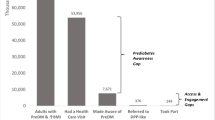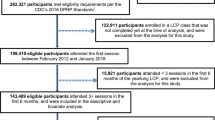Abstract
Approximately 8.3% of the US population has diabetes and estimates indicate that 79 million adults have prediabetes and 33.8% are obese, increasing their risk of diabetes. The national Diabetes Prevention Program (DPP) and subsequent translation studies have demonstrated the efficacy of the DPP lifestyle intervention (DPPLI) on lowering weight and reducing risk of type 2 diabetes over 10 years. Innovative strategies are needed to translate the DPPLI to reach people at risk of diabetes. Community health workers represent a group of individuals poised to play a role in supporting the translation of the DPPLI, especially in underserved populations. This article aims to 1) describe community health workers in general; 2) describe their role and impact on diabetes care in general; and 3) provide a detailed overview of studies involving community health workers in the translation of the DPPLI.
Similar content being viewed by others
References
Papers of particular interest, published recently, have been highlighted as: • Of importance •• Of major importance
Whiting D, Guariguata L, Weil C, et al. IDF Diabetes Atlas: global estimates of the prevalence of diabetes for 2011 and 2030. Diabetes Res Clin Pract. 2011;94:311–21.
Centers for Disease Control and Prevention: National diabetes fact sheet, 2011. Available at http://www.cdc.gov/diabetes/pubs/pdf/ndfs_2011.pdf. Accessed December 2011.
Centers for Disease Control and Prevention, Division of Nutrition, Physical Activity, and Obesity, National Center for Chronic Disease Prevention and Health Promotion: U.S. Obesity Trends. Available at http://www.cdc.gov/obesity/data/trends.html. Accessed December 2011.
Centers for Disease Control and Prevention, Division of Nutrition, Physical Activity, and Obesity, National Center for Chronic Disease Prevention and Health Promotion: Adult Obesity. Available at http://www.cdc.gov/obesity/data/adult.html. Accessed December 2011.
National Diabetes Information Clearinghouse: Diabetes Prevention Program. Available at http://diabetes.niddk.nih.gov/dm/pubs/preventionprogram/#results. Accessed December 2011.
Centers for Disease Control and Prevention: Obesity: halting the epidemic by making health easier. Available at http://cdc.gov/chronicdisease/resources/publications/aag/obesity.htm. Accessed November 2011.
Centers for Disease Control and Prevention. MMWR Weekly Report: Diabetes – United States, 2004 and 2008. Available at http://www.cdc.gov/mmwr/preview/mmwrhtml/su6001a20.htm?s_cid=su6001a20_w. Accessed November 2011.
Centers for Disease Control and Prevention: CDC Health Disparities & Inequalities Report (CHDIR). Available at http://www.cdc.gov/minorityhealth/CHDIReport.html. Accessed December 2011.
Administration on Aging: A profile of older Americans: 2010. Available at http://aoa.gov/AoAroot/Aging_Statistics/Profile/2010/3.aspx. Accessed December 2011.
Diabetes Prevention Program Research Group. Reduction in the incidence of type 2 diabetes with lifestyle intervention or metformin. N Engl J Med. 2002;346:393–403.
Diabetes Prevention Program Research Group. 10-year follow-up of diabetes incidence and weight loss in the diabetes prevention program outcomes study. Lancet. 2009;374:1677–86.
• Ackermann RT, Finch EA, Brizendine E, et al. Translating the diabetes prevention program into the community. The DEPLOY pilot study. Am J Prev Med. 2008;35:357–363. This is a cluster randomized study conducted in the community that compared the effects of DPPLI versus brief counseling in adults at risk of diabetes on HbA 1c , blood pressure, cholesterol and weight at 6 and 12 months.
Amundson HA, Butcher MK, Gohdes D, et al. Translating the diabetes prevention program into practice in the general community: findings from the Montana cardiovascular disease and diabetes prevention program. Diabetes Educ. 2009;35:209–10.
Boltri JM, Davis-Smith YM, Seale JP, et al. Diabetes prevention in a faith-based setting: results of translational research. J Publ Health Manag Pract. 2008;14:29–32.
Davis-Smith YM, Boltri JM, Seale JP, et al. Implementing a diabetes prevention program in a rural African-American church. J Natl Med Assoc. 2007;99:440–6.
Dodani S, Kramer MK, Williams L, et al. Fit body and soul: a church-based behavioral lifestyle program for diabetes prevention in African Americans. Ethn Dis. 2009;19:135–41.
Jackson L. Translating the diabetes prevention program into practice: a review of community interventions. Diabetes Educ. 2009;35:309–20.
•• Katula JA, Vitolins MZ, Rosenberger EL, et al. One-year results of a community-based translation of the diabetes prevention program: healthy-living partnerships to prevent diabetes (HELP PD) project. Diabetes Care. 2011;34:1451–1457. This is a randomized controlled trial implementing the DPPLI in community settings, led by CHWs, and evaluating the effect on fasting glucose, insulin, insulin resistance, weight, and waist circumference at 6 and 12 months.
Kramer MK, McWilliams JR, Chen HY, et al. A community-based diabetes prevention program: evaluation of the group lifestyle balance program delivered by diabetes educators. Diabetes Educ. 2011;37:659–68.
McTigue KM, Conroy MB, Hess R, et al. Using the internet to translate an evidence-based lifestyle intervention into practice. Telemed J E Health. 2009;15:851–8.
•• Ruggiero L, Oros S, Choi YK. Community-based translation of the diabetes prevention program’s lifestyle intervention in an underserved Latino population. Diabetes Educ. 2011;37:564–572. This is a nonrandomized prospective single-group study applying CBPR approaches to translate DPPLI into the Latino community to assess changes in measures of obesity, physical activity, and eating habits.
• Seidel MC, Powell RO, Zgibor JC, et al. Translating the diabetes prevention program into an urban medically underserved community: a nonrandomized prospective intervention study. Diabetes Care. 2008;31:684–689. This is a nonrandomized single group study evaluating the translation of a 12-week DPPLI for obese patients from an urban underserved community.
Vadheim LM, McPherson C, Kassner DR, et al. Adapted diabetes prevention program lifestyle intervention can be effectively delivered through telehealth. Diabetes Educ. 2010;36:651–6.
World Health Organization: The World Health Report 2006 - working together for health. Available at http://www.who.int/whr/2006/en/. Accessed November 2011.
Global Health Workforce Alliance, World Health Organization: Global experience of community health workers for delivery of health related millennium development goals: a systematic review, country case studies, and recommendations for integration into national health systems. Available at http://www.who.int/workforcealliance/knowledge/publications/CHW_FullReport_2010.pdf Accessed December 2011.. Accessed December 2011.
U.S. Department of Health and Human Services, Health Resources and Services Administration, Bureau of Health Professions: Community health worker national workforce study, March 2007. Available at http://bhpr.hrsa.gov/healthworkforce/reports/chwstudy2007.pdf. Accessed March 2009.
American Association of Diabetes Educators: Guidelines for the practice of diabetes education. Available at http://www.diabeteseducator.org/DiabetesEducation/position/Practice_Guidelines.html. Accessed December 2011.
American Association of Diabetes Educators: Competencies for diabetes educators. Available at http://www.diabeteseducator.org/DiabetesEducation/position/competencies.html. Accessed December 2011.
American Association of Diabetes Educators: A sustainable model of diabetes self-management education/training involves a multi-level team that can include community health workers. Available at: http://www.diabeteseducator.org/export/sites/aade/_resources/pdf/research/Community_Health_Workers_White_Paper.pdf. Accessed November 2011.
American Association of Diabetes Educators. AADE position statement: community health workers in diabetes management and prevention. Diabetes Educ. 2009;35:48S–52S.
Norris SL, Chowdhury FM, Van Le K, et al. Effectiveness of community health workers in the care of persons with diabetes. Diabet Med. 2006;23:544–56.
Castillo A, Giachello A, Bates R, et al. Community-based diabetes education for Latinos: the Diabetes Empowerment Education Program. Diabetes Educ. 2010;36:586–94.
Lorig K, Ritte PL, Villa FJ, et al. Community-based peer-led diabetes self-management: a randomized trial. Diabetes Educ. 2009;35:641–51.
Davis KL, O’Toole ML, Brownson CA, et al. Teaching how, not what: the contributions of community health workers to diabetes self-management. Diabetes Educ. 2007;33:208S–15S.
Philis-Tsimikas A, Walker C, Rivard L, et al. Improvement in diabetes care of underinsured patients enrolled in project dulce: a community-based, culturally appropriate, nurse case management and peer education diabetes care model. Diabetes Care. 2004;27:110–5.
Babamoto KS, Sey KA, Camilleri AJ, et al. Improving diabetes care and health measures among Hispanics using community health workers: results from a randomized controlled trial. Health Educ Behav. 2009;36:113–26.
Gerber BS, Cano AI, Caceres ML, et al. A pharmacist and health promoter team to improve medication adherence among Latinos with diabetes. Ann Pharmacother. 2010;44:70–9.
Thompson JR, Horton C, Flores C. Advancing diabetes self-management in the Mexican American population: a community health worker model in a primary care setting. Diabetes Educ. 2007;33:159S–65S.
Otero-Sabogal R, Arretz D, Siebold S, et al. Physician-community health worker partnering to support diabetes self-management in primary care. Qual Prim Care. 2010;18:363–72.
•• Mau MK, Keawe’aimoku Kaholokula J, West MR, et al. Translating diabetes prevention into Native Hawaiian and Pacific Islander communities: the PILI ’ohana pilot project. Progress in Community Health Partnerships. 2010;4:7–16. This study reports the translation of DPPLI to Native Hawaiian and Pacific Islander communities applying CBPR in the design, implementation, and evaluation of a pilot study assessing changes in weight, blood pressure, and lifestyle behaviors.
West DS, Bursac Z, Cornell CE, et al. Lay health educators translate a weight-loss intervention in senior centers: a randomized controlled trial. Am J Prev Med. 2011;41:385–91. This is a cluster-randomized controlled trial that compares an adaptation of DPPLI for obese older adults conducted by lay health educators versus a cognitive training control group and measuring weight loss at 4 months post-intervention.
Centers for Disease Control, Division of Diabetes Translation: Community health workers/promotores de salud: critical connections in communities. Available at http://www.cdc.gov/diabetes/projects/pdfs/comm.pdf. Accessed March 2010.
Ali MK, Echouffo-Tcheugui JB, Williamson DF. How Effective were lifestyle interventions in real-world settings that were modeled on the Diabetes Prevention Program? Health Affair. 2012;31:67–75.
Acknowledgments
The authors would like to thank Kevin Grandfield for his editorial review of this manuscript. Also, L. Ruggiero’s research described in this paper was supported by Cooperative Agreement #1-U48-DP-000048 from the US Centers for Disease Control and Prevention (CDC), including support from the Division of Diabetes Translation. The findings and conclusions in this article are those of the authors and do not necessarily represent the official position of the CDC.
Disclosure
Conflicts of interest: L. Ruggiero: has received payment for lectures including service on speakers bureaus and for development of educational presentations for Johnson and Johnson Diabetes Institute; and has received grant support from the National Institutes of Health; A. Castillo: has been a consultant for the American Diabetes Association; has received grant support from the National Institutes of Diabetes, Digestive and Kidney Diseases; National Institute on Aging; Centers for Disease Control and Prevention; and has received payment for lectures including service on speakers bureaus for the National Speakers Network L. Quinn: none; M. Hochwert: none.
Author information
Authors and Affiliations
Corresponding author
Rights and permissions
About this article
Cite this article
Ruggiero, L., Castillo, A., Quinn, L. et al. Translation of the Diabetes Prevention Program’s Lifestyle Intervention: Role of Community Health Workers. Curr Diab Rep 12, 127–137 (2012). https://doi.org/10.1007/s11892-012-0254-y
Published:
Issue Date:
DOI: https://doi.org/10.1007/s11892-012-0254-y




